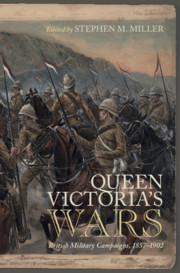Book contents
- Queen Victoria’s Wars
- Queen Victoria’s Wars
- Copyright page
- Contents
- Maps
- Contributors
- Acknowledgements
- 1 Introduction
- 2 The Indian Rebellion, 1857–1858
- 3 Punitive Expeditions in China, 1857–1860
- 4 The Expedition to Abyssinia, 1867–1868
- 5 The New Zealand Wars, 1845–1872
- 6 The Third Anglo-Asante War, 1873–1874
- 7 The Second Afghan War, 1878–1880
- 8 The Anglo-Zulu War, 1879
- 9 The First Anglo-Boer War, 1880–1881
- 10 Egypt and the Sudan, 1881–1885
- 11 The Third Anglo-Burmese War and the Pacification of Burma, 1885–1895
- 12 The Tirah Campaign, 1897–1898
- 13 Reconquest of the Sudan, 1896–1898
- 14 The South African War, 1899–1902
- 15 Conclusion
- Index
- References
10 - Egypt and the Sudan, 1881–1885
Published online by Cambridge University Press: 01 June 2021
- Queen Victoria’s Wars
- Queen Victoria’s Wars
- Copyright page
- Contents
- Maps
- Contributors
- Acknowledgements
- 1 Introduction
- 2 The Indian Rebellion, 1857–1858
- 3 Punitive Expeditions in China, 1857–1860
- 4 The Expedition to Abyssinia, 1867–1868
- 5 The New Zealand Wars, 1845–1872
- 6 The Third Anglo-Asante War, 1873–1874
- 7 The Second Afghan War, 1878–1880
- 8 The Anglo-Zulu War, 1879
- 9 The First Anglo-Boer War, 1880–1881
- 10 Egypt and the Sudan, 1881–1885
- 11 The Third Anglo-Burmese War and the Pacification of Burma, 1885–1895
- 12 The Tirah Campaign, 1897–1898
- 13 Reconquest of the Sudan, 1896–1898
- 14 The South African War, 1899–1902
- 15 Conclusion
- Index
- References
Summary
The first part of the chapter analyses the disparity of the forces involved and Wolseley’s calculations once the intervention in Egypt had begun. It traces the manoeuvres of the belligerents, concluding with the Battle of Tel el-Kebir. The relative importance of British and Egyptian technology, cohesion, and command coherence is assessed. The Sudan campaign followed two distinct phases. The first was an attempt to restore Egyptian authority over its colony, and the ongoing resistance from the proclamation of Muhammad Ahmad bin Abd Allah as ‘Mahdi’ in 1881. The disaster of General Hick’s mission offers the opportunity to analyze the belligerents and their strategic designs, tactics, arms, and early manoeuvres. The second phase of the campaign was the attempted evacuation of Khartoum, and its fall in 1885 despite the relief efforts of Wolseley and his Anglo-Egyptian force. Despite the Victorian apotheosis of Gordon, the garrison commander, the focus here is the operational one, especially the evolution of Wolseley’s more scientific approach to campaigning. There are fascinating episodes, such as the Battle of Abu Klea, that challenge the technological-determinist arguments that are used to explain British military success.
Keywords
- Type
- Chapter
- Information
- Queen Victoria's WarsBritish Military Campaigns, 1857–1902, pp. 187 - 219Publisher: Cambridge University PressPrint publication year: 2021

